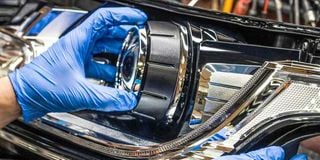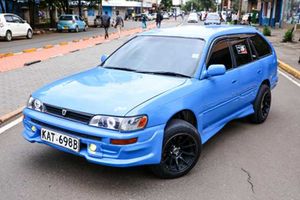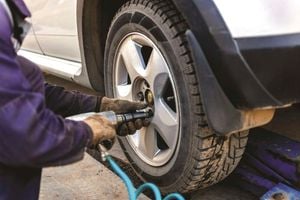
Headlights still have four main elements and all four need to be in harmony and very precise.
What would you say is the single most common fault on cars in Kenya?
Bald tyres? Bad brakes? Smokey exhausts? Oil leaks? Worn suspension bushes? Steering play? Rust? Leaky radiators? Wonky wheel alignment? All of these weaknesses are much more numerous than they should be, but for many years past the Number One error was, and arguably still is, maladjusted headlights.
The blame for this rests with a lack of technical know-how among owners and almost universal negligence by service agents. Most motorists seem to think their headlights are okay as long as both bulbs work, and adjustment checks are rarely a service job-card item.
Some (but far from all) recognise that there needs to be a difference between dip and beam. Even fewer seem to realise how exact the power, shape and direction of a headlight beam must be to ensure good visibility without dazzling oncoming traffic.
The design of lights and bulb technology has changed, but the principles have not. Headlights still have four main elements and all four need to be in harmony and very precise.

A man cleans a car's headlights.
One, they have a “housing” which holds the whole lamp assembly in a steady and exact position.
Two, they have a highly polished (chrome) “reflector” which focuses, shapes, and projects the beam of light in a direction and angle that can be (and needs to be) adjusted to within a millimeter at source!
Three, they have a twin-filament “bulb” that determines the potential power of illumination. In days when headlight light bulbs were the shape and size of large golf balls with tungsten filaments in a capsule of argon gas, the legal max for a dip filament was 45 watts and the beam filament was 55 watts. Less than that, and the lights would not adequately illuminate the road ahead; more than that, and the lights would dazzle other road users even if they were correctly adjusted.
Those numbers have been rendered meaningless by the invention and universal availability of quartz halogen, quartz iodine and LED lights capable of many times greater brightness. You have all had to squint at the consequences. Halogen bulbs of up to 130 watts beam power are on open sale, and incorrect “crackdowns” on spotlights have encouraged their use in headlights. Speed bumps, which dramatically alter the angle of light beams, are a horror show.
Four, headlights have a “lens” made of clear glass. This not only protects the reflector and bulb from water, dirt and damage, but is also “riffled” to further steer and shape the beam in a way that helps the driver and doesn’t hinder others. The riffles are specific to left and right headlights and should never be interchanged. Hah!
The reflector is designed to ensure the beam of light is as horizontal as possible. The lens "riffles" help shape that horizontal beam in exactly the right direction, up, down and sideways. And the bulb is designed with equal precision of power, size, shape and other features to work in exact harmony with the focal point of the reflector, which then sends beams of light in precise harmony with the lens riffles.

If any of those elements is out of kilter, dazzling lightbeams go every which way, illuminating the road less efficiently and dazzling oncoming traffic.
The correct settings are as follows:
The reflector/lens combination should angle the beams slightly left of and slightly below straight-ahead centre. In the absence of special beam adjustment equipment, there is a home-spun method:
First, drive the car right up to the wall, and mark the wall exactly opposite the very centre of each headlight. Then reverse until the front of the car is 7.5 metres (approx 25ft) away from the wall. Turn on the lights. The central and brightest part of the beam should be 20 cms below and 20 cms to the left of the marks on the wall, and both at exactly the same height as each other.

If this pattern cannot be achieved within the range of the adjusting screws, then one or more of the main parts - housing, reflector, bulb and lens - is damaged, or the wrong part, or incorrectly fitted.
The sensible rationale for headlamps is to have lights of the correct power, correctly adjusted, with the correct use of dip and beam, so everybody can see properly without dazzling anyone else. Instead, motorists are fitting more and more powerful bulbs and using full-time full-beam with a mad “self-defence” mentality that is both lunatic and lethal. Dazzling a car that is dazzling you does not solve the problem. It doubles it.
We must somehow start to reverse the vicious circle, and here's a thought which might help start the remedial process:
In a head-on collision, BOTH drivers die.
‘Magic’ additives: a mixed blessing or a mind game?

Coolant additives inhibit rust, reduce the accumulation of dirt and lubricate the water pump.
Many supermarket shelves are laden with all sorts of fancy “additives” and “treatments” to make car engines go better and last longer. Do they really help?
Skeptic.
The benefit of most of these concoctions to a standard car in good condition that is properly and regularly serviced is somewhere between little and nothing. All the ingredients necessary to achieve the “magic” results they claim already exist in the modern fuels and oils you use.
Where they might make a measurable difference (as a one-off rectifier, not as a constant ingredient) is to help rectify poor conditions caused by severe neglect of basic service routines, which have allowed deposits of carbon or other detritus to build up and harden. In this case, “flushing” compounds might provide some remedy but probably not a “cure”, and can be worth using (carefully and conservatively) to delay a more thorough dismantling and overhaul.
The one treatment that is worth using regularly (always) is coolant additives for the radiator, because they do things that plain water does not: they inhibit rust, reduce accumulation of dirt and lubricate the water pump. Their anti-freeze quality (glycol) is real enough, but irrelevant in our climate unless you regularly park your car above the snowline on Mt Kenya.
Wax polishes
The effectiveness of wax polishes for the paintwork is also “real”, but their use should be occasional. Regular (daily?) washing should use plenty of plain water. Only. Where stubborn dirt demands the use of soap, this will remove both the dirt…and the wax…which will then need to be reapplied (too often).
The most common service error in engines is poor procedure at oil changes. The old oil should be drained when the engine is hot and all the impurities are thoroughly churned up. That way the old oil will drain rapidly and all the dirt will depart with it. If the engine is cold when the drain plug is opened, more dirt will have settled as a sediment and the outflow will be slower and leave more dirt behind.
This means the new oil will immediately mix with old pollutants, and if this incorrect procedure is repeated a few times the impurities will start to clog and be “cooked” into a sticky cake. If new oil becomes dark very soon after an oil change, this indicates residual dirt and using an engine flushing oil before the next refill might be worthwhile…if that process, too, is done right. This is not recommended as a regular service procedure. It is a once-or-twice in lifetime option.
You are right to be skeptical about “performance” additives that promise to turn your family car into a Ferrari. There is only one thing that does that: buy a Ferrari.






